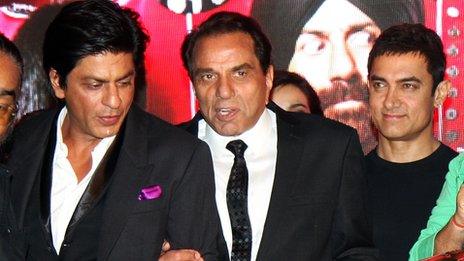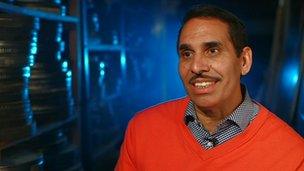How did Bollywood reach Birmingham?
- Published

The well-known Bollywood actor Dharmendra, centre, stars in Yamla Pagla Deewana 2, which was shot in Birmingham, London and Leicester
A century on from the birth of Bollywood, it is no longer just India that is famed for making its colourful, musical films. Over the last decade, Birmingham has become an increasingly popular location and launch pad for the industry.
The use of western cities is a sign of how Indian cinema constantly has to evolve and adapt, according to Amarjit Sidhu, 60, from West Bromwich.
His late father, Jaswant, was hailed as the "pioneer of Indian cinema" and first brought Bollywood films to Britain in the 1950s.
"When he arrived in Wolverhampton in 1952, there was no entertainment for first generation Asians, people living in the Midlands had nowhere to go other than the pub on a Saturday," said Mr Sidhu.

Amarjit Sidhu said Birmingham is becoming increasingly popular for Bollywood film-makers
"So my father and some of his friends thought bringing Indian films here could not only put them in touch with what was happening back home, but also provide a social side to it."
'Part and parcel'
They set up the Eastern Film Society, whose main purpose was to screen films but any money raised was used to help teach English to Indian immigrants.
"It started a trend of Indian cinema up and down the country, people would travel from anywhere to come and watch the films," said Mr Sidhu.
"Bollywood has always been an important part and parcel of being an Asian or Indian, it's always been there."
Piali Ray OBE, the director of Birmingham-based Sampad South Asian Arts, agrees. The group has been marking the centenary of Bollywood with a festival throughout June., external
"Films and cricket are the two most popular forms of entertainment for the south Asian community in Britain and films are hugely popular," said Ms Ray.
"They love the references to their own culture and films go a long way in making that culture accessible to third or fourth generation Asian people.
"I've known parents to even encourage their youngsters to learn Bollywood dancing or music-making because at least they're learning the language, although we have to remember most of the films are total fiction."
She added that Indian cinema was becoming popular with non-Asian audiences and film-makers were appealing to those fans by choosing western locations like Birmingham.
"Many films are subtitled and a lot of the story lines are based in Birmingham or London so some of the scripts are multi-lingual which means both sets of audiences can relate to the films.
"The city itself is well recognised too. I think film-makers like it because of the architecture - you get stately homes as well as the industrial settings.
"Birmingham has a very well-developed network for directors and actors too, both for paid and unpaid roles," said Ms Ray.
She said it was thought the last film to be partly shot in Birmingham, Yamla Pagla Deewana 2, starring actor Dharmendra, generated about £2.5m for the local economy.
While there are "just under a dozen" Bollywood films made in Birmingham each year, Mr Sidhu said that is bound to increase.
"It's not as cheap to make a film here compared to India but the fact that Dharmendra - a well-known Bollywood actor any Asian person will know - and his two sons have been to Birmingham to shoot their film is significant.

Jaswant Sidhu set up the Eastern Film Society in Wolverhampton
"They wanted to put Birmingham on the map, they found things easier to do and the people more accessible.
"That's bound to influence other film-makers, just like if Brad Pitt or Angelina Jolie were to film here or turn up at a premiere."
So what would his father have thought about the rise in Bollywood in Britain, after starting up the Eastern Film Society?
"He always believed in change and that life is about change, he would have known Indian cinema would change dramatically," said Mr Sidhu.
"It's inevitable that somebody else would have started what he did."
- Published24 June 2011
- Published1 June 2013
- Published25 April 2013
- Published3 May 2013